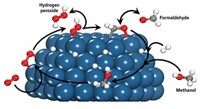Advertisement
Grab your lab coat. Let's get started
Welcome!
Welcome!
Create an account below to get 6 C&EN articles per month, receive newsletters and more - all free.
It seems this is your first time logging in online. Please enter the following information to continue.
As an ACS member you automatically get access to this site. All we need is few more details to create your reading experience.
Not you? Sign in with a different account.
Not you? Sign in with a different account.
ERROR 1
ERROR 1
ERROR 2
ERROR 2
ERROR 2
ERROR 2
ERROR 2
Password and Confirm password must match.
If you have an ACS member number, please enter it here so we can link this account to your membership. (optional)
ERROR 2
ACS values your privacy. By submitting your information, you are gaining access to C&EN and subscribing to our weekly newsletter. We use the information you provide to make your reading experience better, and we will never sell your data to third party members.
Synthesis
Catalyst Promotes Acyl Transfer Three Ways
Palladacycle enhances reaction kinetics by a factor of 100 million
by Stu Borman
December 12, 2011
| A version of this story appeared in
Volume 89, Issue 50
Computation and experiment have been used to design a catalytic process with a three-part mechanism that makes a metal-promoted acyl transfer reaction occur 108 times faster than the uncatalyzed reaction. Nicholas J. Mosey, R. Stan Brown, and coworkers at Queen’s University, in Kingston, Ontario, developed the unusual catalyst, a palladacycle, to promote the methanolysis of a thioamide (J. Am. Chem. Soc., DOI: 10.1021/ja209605r). They report that the catalyst performs three essential roles: substrate binding; nucleophilic delivery of methoxide to form a stabilized version of a tetrahedral intermediate, which would otherwise be an unobservable high-energy intermediate; and palladium assistance (via transient association with nitrogen) for departure of an amide leaving group, usually the most difficult step in amide or thioamide hydrolysis reactions. “The demonstration of this multifaceted catalytic role suggests how biological catalysts might operate in promoting these sorts of difficult reactions,” Brown says. Brown, Mosey, and coworkers are currently studying the palladacycle-catalyzed reactions of different thioamides, evaluating solvent effects and performing theoretical simulations to better understand the reaction’s large rate acceleration.





Join the conversation
Contact the reporter
Submit a Letter to the Editor for publication
Engage with us on Twitter